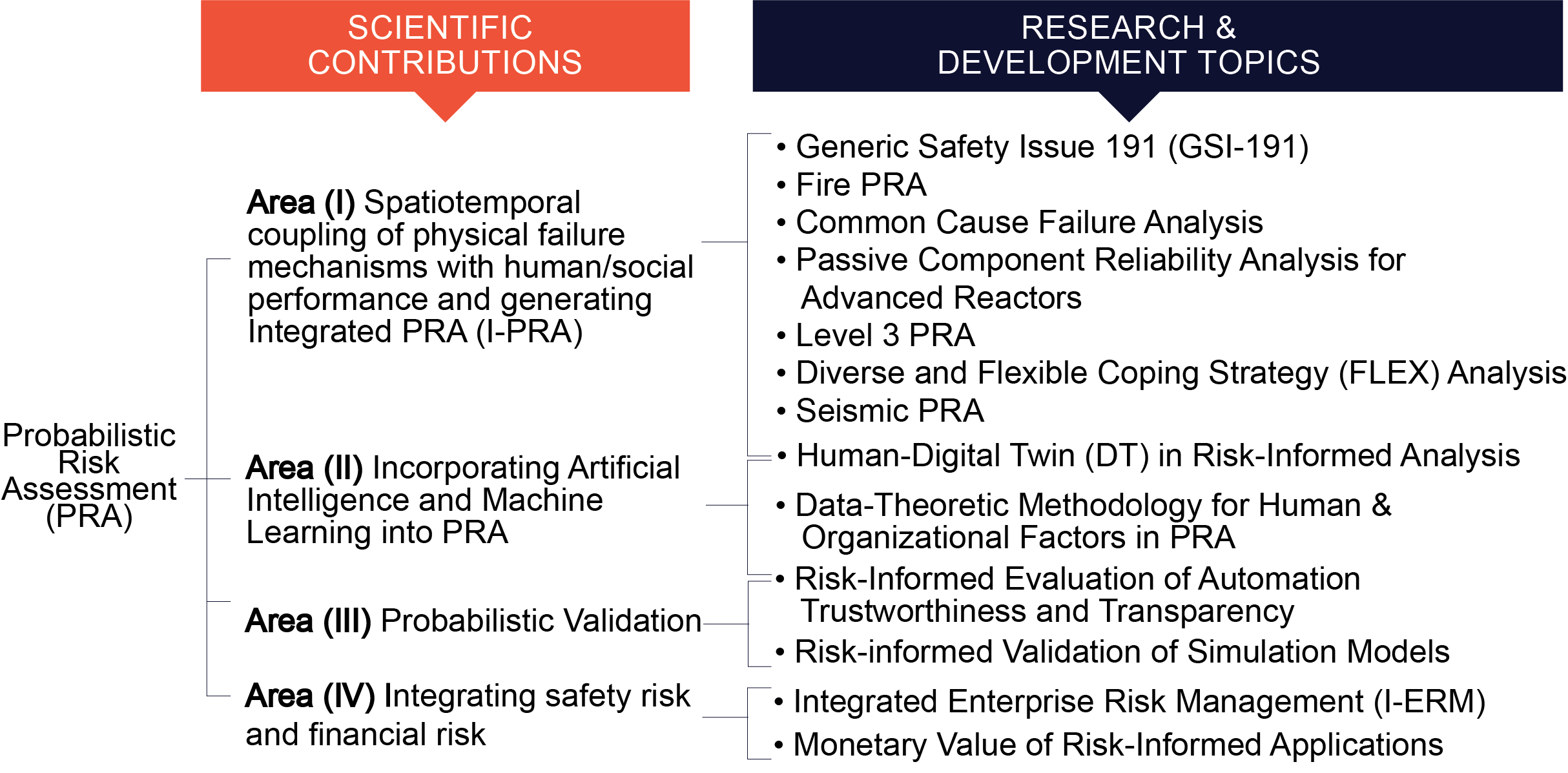Evolution of Probabilistic Risk Assessment (PRA)
The SoTeRiA Research Laboratory is at the forefront of advancing Probabilistic Risk Assessment (PRA). SoTeRiA’s four key areas of scientific contributions to PRA include: Area (I) spatiotemporal coupling of physical failure mechanisms with human/social performance and the incorporation of this coupling into classical PRA using the Integrated PRA (I-PRA) methodology; Area (II) incorporating artificial intelligence (AI) and machine learning (ML) into PRA; Area (III) Probabilistic Validation; Area (IV) integrating safety risk and financial risk.
Grounded in the underlying science, SoTeRiA employs theory-based causal modeling to explicitly model the underlying physical and social failure mechanisms contributing to risk. The use of artificial intelligence and machine learning in the Integrated-PRA approach is opening new opportunities for risk assessment of complex socio-technical systems. By integrating physical and social causes of failure into a cohesive modeling framework, the evolution of PRA is a critical step in moving toward a new era, void of catastrophic technological accidents, where industry-academia projects are leveraged to raise social responsibility for the protection of workers, the public, and the environment.
Examples of SoTeRiA Research Laboratory projects include:
- Fire PRA in nuclear power plants
- Location-specific Loss of Coolant Accidents (LOCA) leading to Emergency Core Cooling System failure
- Modeling the effects of human and organizational factors on nuclear power plants’ technical system failure
- Socio-technical risk-informed emergency preparedness, planning and response modeling for severe accidents
- Evaluating the monetary value of PRA
- Enterprise Risk Management (ERM)
- Spatiotemporal Coupling of Physics of Degradation Phenomena with Maintenance Human/Organizational Factors
- Advancing the I-PRA algorithm for the deployment of new technologies
- Developing risk methodologies for advanced reactors
- Evaluating and improving the trustworthiness and transparency of AI-based automation technologies
The SoTeRiA Research Laboratory’s key research impacts include (1) scholarly contributions to risk analysis of complex socio-technical systems; (2) bridging foundational risk analysis research with industry and regulatory challenges; (3) strong leadership in risk analysis conferences; (4) advancing risk-informed solutions for new technologies; and (5) promoting international safety and security through risk analysis.
PRA Applications for Industry
There are many diverse types of risk assessments since they are applied in different industries and for different goals, often with the commonality of the incorporation of uncertainties. SoTeRiA Research Laboratory is focused on the systematic safety risk of high-consequence industries (e.g., nuclear, space, aviation, healthcare, chemical processing, transportation, oil and gas, etc.). One of the promising methodologies to estimate the safety risk of high-consequence industries is Probabilistic Risk Assessment (PRA). High-consequence industries are associated with complex socio-technical systems dealing with dependencies and uncertainties, where accidents are the result of potential weaknesses that dynamically interact with each other. Due to these interactions, infrequent and rare system-level accidents with high consequences (e.g., Nuclear Power Plant accidents) can occur, therefore, developing risk analysis, by relying solely on statistical data is not adequate for understanding, predicting, and preventing these rare events. To estimate systematic risk for high-consequence industries, in 1975, the PRA methodology was developed in academia (Nuclear Engineering Department at the Massachusetts Institute of Technology) in collaboration with industry.
PRA is now one of the key pillars of the Risk-Informed regulatory framework for the Nuclear Regulatory Commission (NRC). In addition to the NRC, a growing number of government agencies in the U.S., including the Department of Energy (DOE), the Federal Aviation Administration (FAA), the National Aeronautics and Space Administration (NASA), the Department of Defense (DOD), the Environmental Protection Agency (EPA), and the Food and Drug Administration (FDA) have begun to utilize PRA for policy setting and decision-making.
